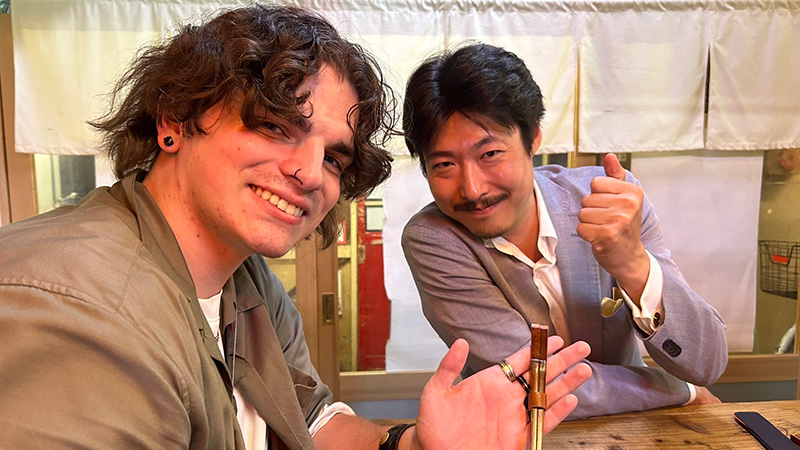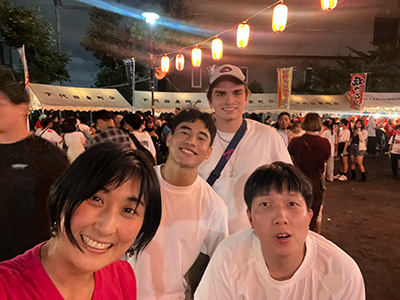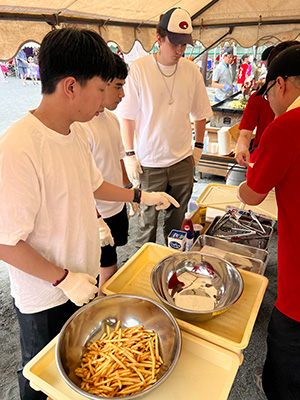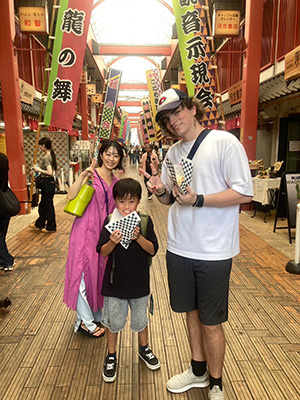
During a 2024 summer internship in Japan, outsider Hal Grigsby becomes an insider. Here he accepts a gift of handmade chopsticks from his friend Hanai-San at the bar Noguchi-Ya where he was a regular.
It would seem Hal Grigsby ’26 has had an affinity for everything Asian since he was a little kid. He loved the food, Chinese in particular, and made a point of learning to use chopsticks, something most American adults can’t do. When his family hosted Chinese, Korean, and Japanese students, he took a deep interest. “I was very young—four, maybe—and I had the opportunity to learn about their culture,” Hal says. He went on to immerse himself in aspects of their culture, such as Pokémon and anime, and at Moravian he has been able to study Japanese language and culture at Lehigh University every semester, leading to a double major in Japanese studies and history.
While exploring a semester abroad program through Temple University, which has a campus in Japan, Hal learned about internship opportunities in the island nation for the summer of 2024. His conversational Japanese helped him secure an opportunity working with Risa Kamio, councilwoman for the Setagaya City Council. Her primary interests are in advocating for mothers and making Setagaya more international, more accommodating to people from other countries. “She believes that inviting in outside cultures could benefit Setagaya in many ways,” Hal explains, “and offers the internship so she can bring international perspectives to her work.”

Hal and his fellow interns, one from Taiwan and another from Hawaii, sat through hours and hours of city council meetings where “the Japanese was very, very complicated and very fast.” Most of their work, however, was translating city documents into English to make them accessible to non-Japanese-speaking individuals, and the three translated a pamphlet about the city council and how residents of Setagaya can best make their concerns known. Hal’s proudest moment was in contributing to a new official English translation of Setagaya’s name.
Setagaya lies within Tokyo and is primarily a residential area, much like a borough in New York City, Hal explains. The English translation is Setagaya Ward, a designation not widely understood outside Japan, so “ward” was replaced with “city.” But, Kamio asked, should we say Setagaya City or City of Setagaya?
Hal researched official references to cities worldwide. “I found that all government-related documents, websites, etc., use ‘City of . . .’: City of New York, City of London, City of Los Angeles.” He recommended City of Setagaya to Kamio, who presented it to the city council, which adopted the name for use on its website and on all communications. “It was really cool to see my work have a real impact in another country,” Hal says.
Community, Culture, and Internationalism

Kamio also asked the interns to assist her at events in the community. “So at this local festival there were three foreigners making french fries and dumplings and corn dogs for a bunch of kids,” Hal says. “We got a lot of stares. They would ask, ‘Why are you helping here? There are no foreigners even in the crowd.’” The surprise issued from excitement and curiosity, not hostility.
Japan’s population is 98 percent Japanese, with much of the remaining 2 percent a mix of Asian ethnicities, Hal says. It can be hard for people from other countries to integrate into a community and culture that is generally homogeneous. Hal, who is comfortable standing out from the crowd, easily made conversation and found the people he spoke with open, hospitable, and engaging. “It was always ‘Try this Japanese drink, try this food. Have you tried this yet? Have you gone here?’ They were excited for us to experience everything.”
As part of the internship, the students attended a community meeting about the building of a new school for special needs children. “The room was filled with parents and grandparents, and I, a 20-year-old college student, got to see them discuss and argue the needs of the school,” Hal says. “Afterward, they came up to us and asked why we were there on a Friday night and not out partying. We told them we were there to learn.
“I would never have experienced that had it not been for the internship, and I wouldn’t have been behind a table with a fryer making food at a festival. I felt I made real connections with people in the community, and they responded positively.”
Personal Learning and Perspectives
Through the internship, Hal gained a deeper appreciation of Kamio’s drive for internationalism. Working in Setagaya, he saw the interest and excitement of the community for people outside their community.

“Realizing what internationalism could bring to Japan, I want to do more,” Hal says. He notes that Japanese people want to learn English, but instruction is poor. And exposure to other cultures could stimulate the somewhat stagnant, stifling mindset. “The Japanese define their culture as a peaceful ignorance,” Hal says. “Living in an island culture, many don’t know what’s going on in the world.”
He acknowledges, too, that the country maintains its homogeneity. “There’s a Japanese saying, ‘The nail that sticks out gets hammered first.’” While Hal appreciates Japanese culture—the kindness and the respect and concern for others—he believes a little bit of sticking out is in order, giving confidence to young people to pursue what they want to do, try something new, travel abroad, and broaden their worldview. The nails that stick out can push forth new ideas and innovation that can revive an economy still lagging in the “lost decade” of the ’90s, Hal points out.
“Through the internship, discovering that I could bring the outsider inside and be welcomed was powerful. I see an opportunity to do a lot for a lot of people.”